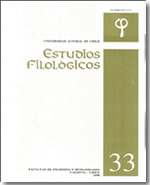Multilingual substratum and superstratum in the toponymy of the south of Chile
Main Article Content
Abstract
Toponyms from native languages occupy a special position among the contributions of those languages to the Spanish of the Americas. Unlike common nouns of similar origin, native toponyms are not subject to social or geographical constraints and are used by all speakers, regardless of region or class. Moreover, they tend to remain valid even after the original languages have been displaced by the dominant languages.
The toponyms of an area in Chile approximately between 42 and 55 degrees south are studied in order to detect the languages that have left their mark. The substratum includes contributions of at least five native languages. The superstratum shows the influence of three European languages in addition to Spanish. The place names show a unique combination of native and European terms, typical of the region studied and quite different from other regions of the country. There is a good relationship between the geo-climatic region and the toponymic data.

